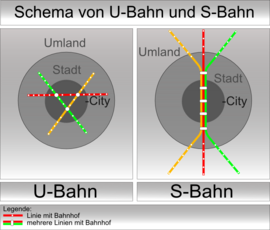
Back إس بان Arabic S-Bahn Czech S-Bahn Danish S-Bahn German S-Bahn Esperanto S-Bahn Spanish S-Bahn Finnish S-Bahn French S-Bahn Hungarian Kereta S ID


The S-Bahn (/ˈɛsbɑːn/ ESS-bahn, German: [ˈɛsˌbaːn] ) is a hybrid urban–suburban rail system serving a metropolitan region predominantly in German-speaking countries. Some of the larger S-Bahn systems provide service similar to rapid transit systems, while smaller ones often resemble commuter or even regional rail systems. The name S-Bahn derives from Schnellbahn (lit. rapid train), Stadtbahn (lit. city train) or Stadtschnellbahn (lit. rapid city train).
Similar systems in Austria and German-speaking Switzerland are known as S-Bahn as well. In Belgium, it is known as S-Trein (Flemish) or Train S (French). In Denmark, they are known as S-tog [ˈesˌtsʰɔˀw], and in the Czech Republic as Esko or S-lines. In Milan, they are known as Linee S.